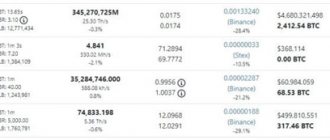Appeared in 2016 as a result of the “twin brother” hard fork of Ethereum (ETH). In other words, this cryptocurrency is the same Ethereum before the hard fork. The goal of the project is to keep the original Ethereum decentralized, immutable, and uncensorable.
A year ago, many considered Ethereum Classic to be “stillborn,” but this turned out to be far from the case. ETC is still in the list of top 10 cryptocurrencies by market capitalization.
An ardent supporter of Ethereum Classic is world-famous crypto enthusiast and head of the Digital Currency Group, Barry Silbert. Largely thanks to his efforts, the ETC cryptocurrency appeared in the professional computer system Bloomberg Terminal.
In general, the growth of Ethereum Classic greatly intensified in the spring of 2017, after the launch of the Ethereum Classic Investment Trust. The further growth of Ethereum Classic expects to be stable, at least thanks to the project’s balanced monetary policy, which provides for limiting emissions and reducing the block reward. In particular, the total number of coins will be approximately 210 million, but not more than 230 million; As for the reward for the mined block, it will be reduced by 20% after block number 5,000,000 and will be reduced by 20% in the future after each subsequent 5 million blocks.
What is DAO
DAO is a global smart contract that played the role of a venture capital fund for financing distributed applications. It appeared in the spring of 2016. As a result, users exchanged their ether for DAO tokens and voted for applications that were supposed to receive part of the invested money for development.
A split was supposed to help get out of the DAO. Token owners united into subsystems and returned the invested cryptocurrency. Hackers took advantage of this trick, created their own subsidiary system and transferred more than $50 million in Ethereum to their accounts.
Ethereum developers decided to solve the problem by rolling back the blockchain to the state before the hacker attack. Part of the community supported the idea, while others were strongly against it. The motivation for refusal is reluctance to interfere with the operation of the blockchain, maintaining the autonomy of the system and ignoring the human factor.
The second part of users abandoned the fork and continued the original blockchain. This is how Ethereum Classic was formed.
Ethereum Classic
The Ethereum Classic currency appeared in connection with the boycott of software updates. The Ethereum Foundation simply deceived the crypto community about the unanimous decision to accept the hard fork. Most of the miners did not participate in the voting, and their votes were counted as “For” - our state reminds us) But not about that. With such a turnout of miners, or rather no turnout, the voting should have failed. But no, they decided everything and did everything against the will of the people. Therefore, I can safely say that enthusiasts who remained faithful to the old software will take ETC to a new level and it will play strong competition with its older brother.
Ethereum classic is the cryptocurrency that was in the beginning, working according to the old algorithm. It has become the fifth largest cryptocurrency by capitalization, surpassing NEM and Litecoin.
Fork Ethereum Classic
ETC's business was stable after the fork. The rate jumped from 1 dollar to three within 10 months. At the end of April 2022, growth began. The peak price of Ethereum Classic occurred on January 14, 2015 and amounted to $45.
Ethereum Classic price chart
Today they offer $6.18 for an ETC coin. Market capitalization is $0.7 billion. The coin trades for the equivalent of $610 million or more per day.
Ethereum Classic Performance
Get ETC wallet address
Full Blockchain Wallet
The Ethereum Classic Full Node Wallet takes up a lot of hard drive space. On the official website you can choose your ETC wallet.
Wallet from the exchange
Ethereum Classic is traded on Binance, Kuna, Crex24 and other exchanges. Register on a cryptocurrency exchange and search for ETC deposit to get your wallet address.
Note. Different countries and regions have different regulatory policies for exchanges, and miners bear the corresponding risks.
Mobile Wallet Applications
You can also use mobile wallets such as Cobo.
Don't know which wallet is better to choose? Read the guide on choosing cryptocurrency wallets.
If you need a flash drive wallet, then see the list of the 10 most reliable and secure hardware wallets.
Profitability of mining Ethereum Classic (ETC)
To calculate profitability we use the 2CryptoCalc calculator. Let's go to the Ethereum Classic page and enter the desired hashrate. For example, this is 1000 Mh/s.
Ethereum Classic mining profitability
As of November 28, 2022, such capacity would bring about $13 per day or $940 per month.
ETFs (Exchange Traded Funds)
Exchange Traded Funds ETFs are UCITS III compliant and typically track the equity or fixed income market. To achieve their investment goals, ETF fund management companies may use physical or synthetic replication (copying) of the tracked database.
Physical replication can be achieved through full copying or optimized sampling. The optimized sampling strategy is more often found when tracking indexes with a large number of assets in the basket, where the portfolio includes only a portion of the total universe of a large index that reflects the same risk-return profile as the underlying index. After all, in many cases it is not practical to build ETFs with thousands of individual holders (including those with significant liquidity issues).
When using synthetic replication, swap agreements are entered into with one or more counterparties. The ETF provider agrees to pay the return on a pre-designated basket of securities to the swap provider in exchange for the return of the index. In general, synthetic replication reduces the fund's costs and reduces the deviation from the underlying index, but the risk of failure of both parties is higher. Using a swap allows you to work with hard-to-reach markets, which is an absolute advantage over physical replication.
Mining Ethereum Classic
Today, for solving a block on the network they give 3.2 ETC and a commission on top. That works out to about $20 at today's exchange rate.
ETC pool 2Miners
A power of 1000 Mh/s is enough to find one block every two days. This is too much, so don't play solo. If your capacity is less than 2Gh/s, use shared pools. By the way, the 2CryptoCalc calculator will help you assess the prospects for mining the desired coin at your hashrate.
[edit] See also
- List of Latin abbreviations
- brb, church
- AFK
- C.Y.A.
- WTF
- LOL
- OMG
- BRB
- etc.
| [ + ] Etc is JAFA | |||
| |||
Miner settings for Ethereum Classic
On November 28, 2022, a hard fork of Ethereum Classic called Thanos took place. Its main task is to change the mining algorithm to Etchash and reduce the size of the DAG file, as a result of which it will be possible to mine ETC on video cards even with 3 GB of memory.
At the same time, the network will be protected from ASIC miners; in addition, it will not be supported by the NiceHash platform. Accordingly, 51 percent attacks on ETC should become a thing of the past.
Here are the current settings for mining cryptocurrency on the 2Miners pool.
The first is the .bat file for the T-Rex miner.
t-rex.exe -a ethash --coin etc -o stratum+tcp://etc.2miners.com:1010 -u 0x00192Fb10dF37c9FB26829eb2CC623cd1BF599E8.RIG_ID -px --fork-at etchash=epoch:390 pause
Below are the settings for Gminer. Which supports automatic switching to Etchash.
miner.exe --algo etchash --server etc.2miners.com:1010 --user 0x00192Fb10dF37c9FB26829eb2CC623cd1BF599E8.RIG_ID
And here are the settings for lolMiner, a review of which is available at the link.
lolMiner.exe --algo ETCHASH --pool etc.2miners.com:1010 --user 0x00192Fb10dF37c9FB26829eb2CC623cd1BF599E8.RIG_ID pause
And settings for PhoenixMiner.
PhoenixMiner.exe -pool etc.2miners.com:1010 -wal 0x00192Fb10dF37c9FB26829eb2CC623cd1BF599E8.RIG_ID -coin etc
It is very important to replace the specified address with your own in order to receive a reward. The current versions of miners are, as always, in this archive. The password for it is 2miners, with a small letter and without any spaces.
Examples of using etc.
Let's now look at a few examples in which etc is appropriate.
We have a constant battle against garden pests such as slugs, snails, insects , etc. — We have a constant battle with garden pests such as slugs, snails, insects and others .
Pigment is mixed into oil, glue, egg, etc. , to make different types of paint. - Pigment is mixed with oil, glue, egg, etc. to make various types of paints.
I like sweet food, such as chocolate, vanilla, honey , etc. — I like sweet foods such as chocolate, vanilla, honey and so on.
For our body is very important the full content of vitamins such as ABC etc. — For our body, the full content of vitamins such as A, B, C and others is very important.
that generated electricity without harming for our planet, such as solar panels, wind turbines, etc. — Green energy technologies are methods by which electricity was generated without harming the planet, such as solar panels, wind generators, etc.
Why do you need a .bat file?
A miner is a program without a visual interface that runs in the console. When starting the miner, it needs to “pass” the parameters with which it will work. To avoid having to do this using the command line, we create a .bat file. Its only purpose is to transmit the pool address, wallet number, farm name and other parameters to the miner. You can edit the .bat file using any text editor.
After that, run the file and admire the numbers in the console. Among other things, it contains our video cards with hashrate and name.
The /etc directory on Linux systems.
Tell your friends about the article... VK
In one of the previous topics, we looked at the structure of the Linux file system. Let's continue to study the composition in more detail, starting with the /etc directory.
/etc directory
The /etc directory contains configuration files; let’s look at each of them in more detail.
/etc/rc.d
contains basic scripts for organizing the download process;
/etc/passwd
file where we can find information about users in the form of a list.
/etc/fdprm
Table of floppy drive parameters that determines the recording format. Set by the setfdprm program.
/etc/fstab
We can see information about the system, which disk partitions need to be mounted when it starts. Command mount -a (it is launched from the command file /etc/rc.d/rc.S). It also contains information about swap areas that are automatically installed with swapon -a.
/etc/group
file where we can find information about user groups in the form of a list.
/etc/inittab
Daemon configuration file init.
/etc/issue
A file containing system information with a login invitation. The parameters and possible keys are presented below, by default in the /etc/issue/ file it looks like this:
\S Kernel \r on an \m
issue file keys :
b Insert the current line speed. d Inserts the current date. s Insert the system name, operating system name. l Insert the name of the current terminal. m Insert a system architecture identifier, for example i686. n Inserts the hostname of the machine, also known as the hostname. o Insert the domain name of the machine. r Insert the kernel release number, for example 2.6.11.12. t Inserts the current time. u Insert the number of users currently logged into the system. U Insert the line “1 user” or “users”, where is the number of currently registered users. v Insert the OS version, such as build date, etc.
/etc/magic
Command configuration file file. Contains descriptions of the various file formats that this command uses to determine the file type.
/etc/motd
A file in which you can specify a welcome message upon successful connection to the system. Often used to inform users about changes in system operation.
/etc/mtab
List of file systems currently available.
/etc/shadow
Shadow user database. This moves the information from the /etc/passwd file to /etc/shadow, which is accessible by root and includes encrypted password information
/etc/login.defs
The login command configuration file contains the values of user password parameters: password expiration period, password length, the need to create the user's home directory, user group identifier.
/etc/printcap
a file where printer information must be configured to enable printing.
/etc/profile
The file is executed by the Bash shell at system startup, allowing system settings to be changed for all users.
/etc/securetty
Defines the terminals from which the root user can connect to the system. These are usually only virtual consoles, which makes it difficult to hack the system via modem or network. Approximate view:
[ [email protected] vi]# cat /etc/securetty vc/1 vc/2 vc/3 vc/4 vc/5 vc/6 vc/7 vc/8 vc/9 vc/10 vc/11 tty1 tty2 tty3 tty4 tty5 tty6 tty7 tty8 tty9 tty10 tty11
It's better to leave only tty1 :
[ [email protected] vi]# echo tty1 > /etc/securetty
/etc/shells
List of working shells. The chsh command allows you to change the working shell only to the shells found in this file. The ftрd process, which provides work with FTP, checks for the presence of the user's shell in the /etc/shells file and does not allow the user to connect to the system until its name is found in this file.
Tell your friends about the article... VK











